How to Grow and Care for Brussels Sprouts: Easy Success Strategies
- May 8, 2024
- 0 comment
Discover how to grow and care for Brussels sprouts with our easy guide! Achieve a bountiful harvest with simple steps. Dive into the ultimate guide on how to grow and care for Brussels sprouts with ease! Whether you’re a seasoned gardener or a beginner, this article will walk you through each step of the process, ensuring you can cultivate these nutritious greens effortlessly.
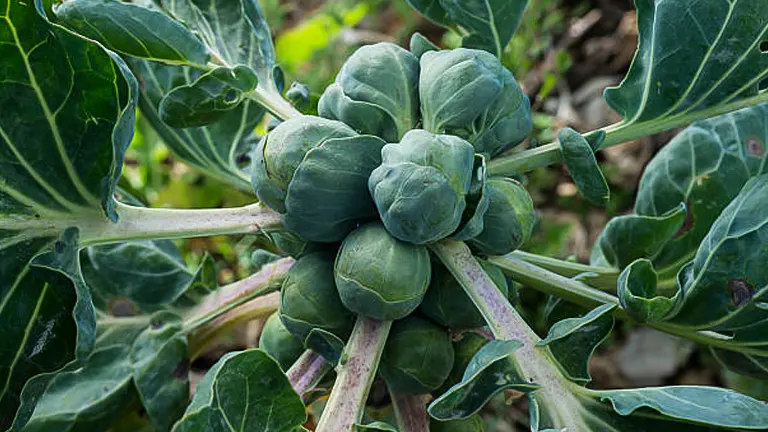
From selecting the right soil to harvesting your sprouts at peak freshness, follow our expert advice for a successful and bountiful garden.
Table of Contents
- Understanding Brussels Sprouts
- Preparing to Plant
- Planting Your Brussels Sprouts
- Maintenance and Care
- Harvesting and Storing
- Troubleshooting Common Issues
- Conclusion
- FAQs
Understanding Brussels Sprouts
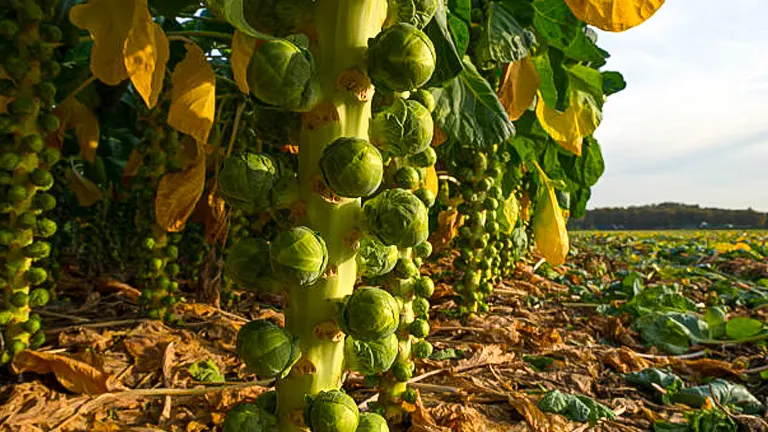
Brussels sprouts, scientifically known as Brassica oleracea gemmifera, are a cultivar group of the Brassica family, which also includes broccoli, cabbage, and kale. This group is notable for its rich nutrient content and robust growth in cooler climates.
Nutritional Profile: Brussels sprouts are exceptionally rich in vitamins C and K, with 100 grams serving providing over 120% of the recommended daily value for Vitamin C and nearly 200% for Vitamin K. They are also a good source of folate, manganese, vitamin B6, dietary fiber, choline, copper, vitamin B1, potassium, phosphorus, and omega-3 fatty acids. These nutrients contribute to their health benefits, such as antioxidant properties, aiding in bone health, and anti-inflammatory effects.
Cultivation Needs: Brussels sprouts are biennials in their natural growth cycle, which means they typically take two years to complete their biological lifecycle. However, they are grown as annuals for agricultural purposes. They require a well-defined growing season and are sensitive to temperature variations. The ideal temperatures for their growth range from 45°F to 75°F (7°C to 24°C). They thrive in environments with prolonged cool seasons, which help them develop their characteristic flavor and compact sprouts.
Scientific Insights: Research indicates that the glucosinolates found in Brussels sprouts—compounds also present in other cruciferous vegetables—are potent inducers of detoxification enzymes and may offer protection against some forms of cancer. Their efficacy is linked to the method of preparation; for instance, steaming has been shown to maximize their anti-cancer properties better than other cooking methods.
Ideal Growing Conditions for Brussels Sprout
| Parameter | Specific Value | Notes |
|---|---|---|
| Germination Temperature | 45°F – 85°F (7°C – 29°C) | Optimal soil temperature for seed germination. |
| Growth Temperature | 60°F – 65°F (16°C – 18°C) | Ideal daytime temperatures for plant development. |
| Frost Tolerance | Down to 20°F (-6°C) | Mature plants tolerate frosts; improves flavor. |
| Daylight Requirements | 10-14 hours daily | Full sunlight is essential for optimal growth. |
| Soil Nutrient Content | High nitrogen and potassium levels | Apply a balanced N-P-K fertilizer initially; supplement with nitrogen if leaves yellow. |
| Planting Depth | 0.25 – 0.5 inches (0.64 – 1.27 cm) | Seeds should not be sown too deeply. |
| Sprout Maturation Time | 90 – 180 days | Time from planting to harvest depends on climate and variety. |
For successful cultivation, Brussels sprouts require consistent attention to temperature and moisture levels. A drop below 45°F (7°C) can halt growth but usually does not harm the plant, making them ideal for fall or early winter harvests in many temperate regions. Their growth cycle is typically around 6 months, depending on the variety and environmental conditions.
Preparing to Plant
Choosing the Right Seeds
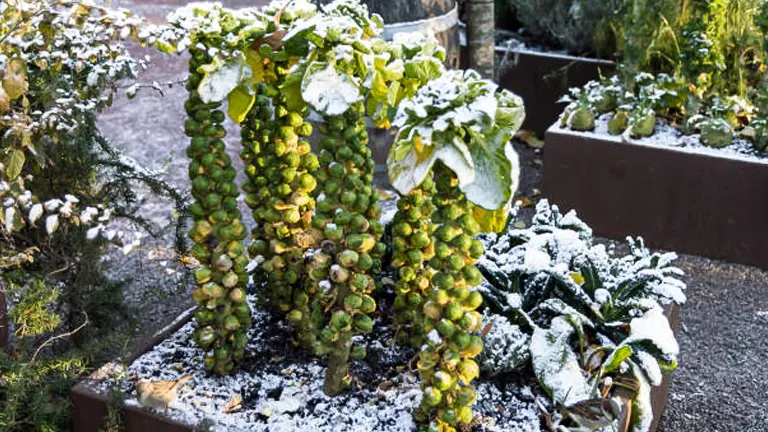
The selection of seeds is a foundational step in successful Brussels sprout cultivation. High-quality seeds ensure genetic robustness and improved germination rates. When selecting seeds, consider the following:
- Hybrid Varieties: Developed through controlled methods of pollination, hybrid seeds are designed to produce plants that are vigorous, uniform, and resistant to certain pests and diseases. They are ideal for gardeners looking for reliability and high yield.
- Heirloom Varieties: Heirloom seeds are passed down through generations and are not genetically modified. They often yield crops with greater flavor diversity and can help preserve genetic diversity in agricultural ecosystems.
- Disease Resistance: Look for seeds that are labeled for resistance to common diseases affecting Brussels sprouts, such as fusarium wilt and powdery mildew. This can greatly reduce the need for chemical interventions later in the growing season.
Soil Preparation
Brussels sprouts demand specific soil conditions for optimal growth. They thrive in well-drained, fertile soil that can retain moisture without becoming waterlogged. Here are some advanced tips for preparing your soil:
- Soil Texture and Structure: Loamy soil is ideal because it holds nutrients and water well while allowing excess water to drain. Incorporating organic matter such as compost or well-rotted manure improves the structure and fertility of the soil.
- pH and Nutrient Optimization: Brussels sprouts prefer slightly acidic to neutral soil, with a pH of 6.0 to 6.8. Testing your soil’s pH can guide your amendments—use lime to raise the pH or sulfur to lower it. A balanced, slow-release fertilizer rich in nitrogen, phosphorus, and potassium can be added to prepare the soil before planting.
- Microbial Health: Healthy soil microbiome can enhance nutrient uptake and improve plant health. Incorporate biofertilizers or compost tea to increase microbial activity in the soil.
Detailed Seed Selection and Soil Preparation Parameters
| Parameter | Detail | Importance |
|---|---|---|
| Seed Germination Rate | 85-95% ideal | Higher rates indicate fresher, more viable seeds. |
| Soil Organic Matter Content | 5-10% recommended | Essential for nutrient retention and soil structure. |
| Soil Nutrients (N-P-K) | 150-200 ppm N, 30-50 ppm P, 250-350 ppm K | Balanced nutrients are crucial for growth phases from germination to maturity. |
| Microbial Activity | High microbial biomass recommended | Promotes nutrient cycling and plant growth. |
| pH Adjustment | Lime or sulfur based on pH test results | Ensures nutrient availability and prevents metal toxicity. |
By emphasizing scientifically accurate and practical gardening tips, this enhanced section helps readers prepare optimally for growing Brussels sprouts, setting the foundation for healthy and productive plants.
Planting Your Brussels Sprouts
Timing and Techniques for Planting

The timing of planting Brussels sprouts is crucial to ensure they mature under ideal temperature conditions. Here’s a detailed approach:
- Indoor Sowing: Starting seeds indoors approximately 4-6 weeks before the last expected frost allows Brussels sprouts to establish themselves in a controlled environment. Use peat pots or biodegradable planters to minimize root disturbance during transplanting.
- Hardening Off: Before transplanting outdoors, it’s essential to harden off seedlings. Gradually expose them to outdoor conditions over a week to strengthen their stress tolerance and reduce transplant shock.
- Transplanting: Choose a cloudy day or late afternoon to transplant seedlings to reduce exposure to harsh sunlight. Ensure the soil is moist and the seedlings are watered thoroughly after planting to help establish roots in their new environment.
Spacing for Optimal Growth
Spacing is a critical factor in the cultivation of Brussels sprouts, affecting everything from airflow to nutrient access:
- Row and Plant Spacing: Adequate spacing is crucial for air circulation, which helps prevent fungal diseases and provides enough space for each plant to grow robustly. For medium to high-density plantings, maintain 18 to 24 inches between plants and 24 to 30 inches between rows.
- High-Density Considerations: In high-density setups, it’s vital to balance the number of plants with available resources. Overcrowding can stunt growth and reduce yield. Use vertical space if possible, and consider the shadow cast by mature plants to ensure all receive sufficient sunlight.
Advanced Planting Parameters for Brussels Sprouts
| Parameter | Specific Value | Detailed Explanation |
|---|---|---|
| Critical Photoperiod | >14 hours of daylight | Brussels sprouts require long daylight hours to prevent bolting and to initiate proper sprout development. |
| Optimal Germination Temperature | 77°F (25°C) | Ideal soil temperature for maximum seed germination efficiency. Lower temperatures may delay germination. |
| Seedling Emergence Time | 5-8 days after planting | Timeframe in which seedlings typically emerge, dependent on soil temperature and moisture levels. |
| Nitrogen Requirement Early Stage | 50 ppm in soil | Amount of nitrogen required in the soil for the initial four weeks post-transplant to promote vigorous leaf growth. |
| Potassium to Nitrogen Ratio | 1:1.5 K:N ratio | Balanced potassium and nitrogen levels promote healthier, sturdier plants and better sprout development. |
| Soil Aeration Index | >20% air-filled porosity | Optimal soil aeration necessary to prevent root diseases and ensure healthy root development. |
| Light Intensity Requirement | 200 Micromole per second and square meter (µmol/m²/s) | Minimum photosynthetic photon flux density required for effective photosynthesis during peak growth hours. |
| Water Uptake Rate | 1 inch per week | Rate of water absorption necessary to maintain optimal soil moisture without causing waterlogging. |
Maintenance and Care
Watering and Nutrition
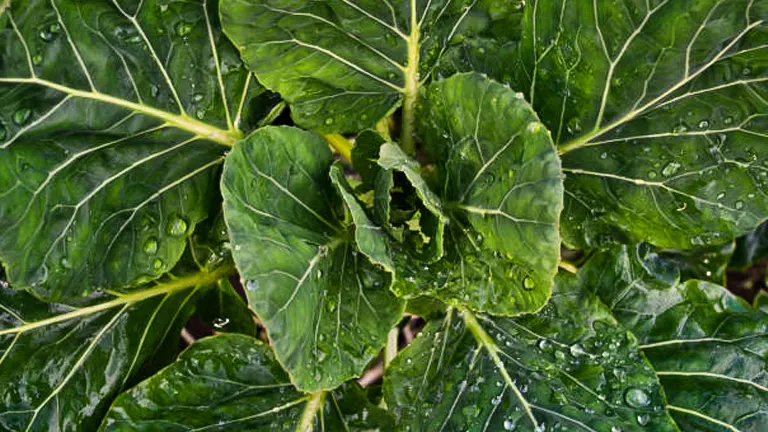
Proper hydration and nutrition are crucial for the healthy growth of Brussels sprouts. These plants thrive in soil that retains moisture without becoming waterlogged. Utilizing a rain gauge helps gardeners precisely measure the 1 to 1.5 inches of water needed weekly, ensuring optimal soil hydration for sprout development.
- Nutritional Requirements: A balanced approach is essential, starting with a slow-release fertilizer with an N-P-K ratio of 10-10-10 at planting. As sprouts begin to form, a boost with a nitrogen-rich formula is beneficial to support vigorous growth and sprout development. Leaf color and growth rates are key indicators of nutritional sufficiency or deficiency.
Weeding and Mulching
Effective weed management ensures that Brussels sprouts do not compete for essential nutrients and water. Applying a 2-3 inch layer of organic mulch, such as straw or finely shredded bark, provides multiple benefits:
- Soil Temperature Regulation: Mulch acts as an insulator, keeping the soil warm during cooler days and cool during hot days, which is vital for consistent growth.
- Nutrient Recycling: As organic mulch decomposes, it gradually releases nutrients back into the soil, enriching it and supporting plant health.
Pruning Techniques
Pruning in Brussels sprouts is targeted primarily at improving plant health and optimizing fruit production:
- Air Circulation Improvement: By removing lower leaves, especially those that show signs of aging or disease, you can enhance air circulation, reducing the risk of fungal infections.
- Energy Redistribution: Selective removal of older leaves can help redirect the plant’s energy towards producing larger and more uniform sprouts at the stalk’s top.
Pest and Disease Management
Maintaining vigilance against pests and diseases is critical for ensuring the health of Brussels sprouts. Organic treatments such as insecticidal soaps and neem oil are preferred for their effectiveness and environmental safety. Regular plant inspections allow for early detection and intervention, crucial for managing potential outbreaks.
- Disease Prevention: Strategies like maintaining proper soil pH and ensuring good drainage are foundational. Crop rotation helps prevent the accumulation of soil-borne pathogens, reducing the incidence of diseases like clubroot and powdery mildew.
Advanced Soil Health Monitoring
Continual soil health monitoring using advanced testing can greatly enhance cultivation practices:
- pH Management: Keeping soil pH within the optimal range (6.0 to 6.8) ensures nutrient availability and prevents toxicities.
- Microbial Activity: High microbial activity in soil contributes to nutrient breakdown and improved plant absorption, fostering robust plant growth.
Precision Agronomy Metrics for Brussels Sprouts Cultivation
| Parameter | Optimal Value | Scientific Explanation |
|---|---|---|
| Soil Particle Density (SPD) | 1.3-1.5 g/cm³ | Reflects the mass per volume of soil particles. Optimal SPD supports root growth and nutrient uptake by ensuring sufficient pore space for air and water infiltration. |
| Photosynthetically Active Radiation (PAR) | 400-700 Micromole per second and square meter (µmol/m²/s) | The amount of light available for photosynthesis. Optimal PAR ensures the plants have enough energy for growth and development. |
| Leaf Area Index (LAI) | 3-5 | The area of leaves per unit area of ground. An optimal LAI maximizes light interception and photosynthetic capacity without excessive self-shading. |
| Diurnal Temperature Range (DTR) | 15°C (day) / 10°C (night) | The temperature variation between day and night affects metabolic processes in Brussels sprouts. Controlled DTR can enhance flavor development by modulating the synthesis of sugars and organic acids. |
| Soil Nutrient Release Rate (SNRR) | Balanced release as per crop demand | Measures how quickly nutrients are made available from the soil, ensuring that Brussels sprouts receive sustained nutrition without periods of deficiency or excess, which can impact growth and sprout quality. |
| Atmospheric CO2 Concentration | 400-450 ppm | Ambient carbon dioxide levels can influence photosynthesis rates. Controlled enrichment in greenhouse settings can increase biomass production and yield. |
| Root Zone Moisture Content (RZMC) | 20-30% volumetric water content | Optimal moisture levels in the root zone are critical for maintaining cellular functions and nutrient absorption without risking root hypoxia or waterlogging. |
| Total Dissolved Solids (TDS) in Irrigation Water | 150-500 ppm | Indicates the concentration of soluble salts in irrigation water. Keeping TDS within this range prevents salt stress that can inhibit plant growth and reduce sprout quality. |
Harvesting and Storing
When to Harvest Brussels Sprouts
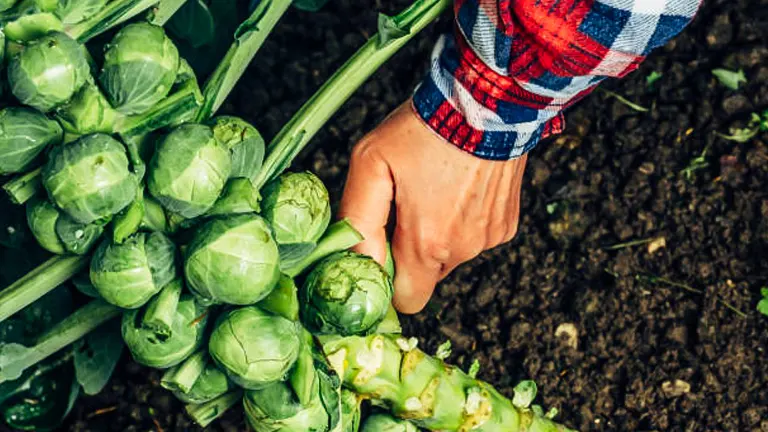
Brussels sprouts are unique in that they taste better after the first frost, which can sweeten the sprouts. The harvest typically begins in the fall and can continue through early winter, depending on your climate. Sprouts should be firm and green, about 1 to 1.5 inches in diameter. Harvest sprouts from the bottom of the stalk upward, as the lower sprouts mature first.
Storing Brussels Sprouts
After harvesting, Brussels sprouts can be stored in the refrigerator for several weeks. For long-term storage, blanching sprouts and then freezing them is an effective method. Ensure sprouts are dry before placing them in airtight bags or containers to prevent ice formation. Properly stored, Brussels sprouts can be enjoyed throughout the winter months.
Troubleshooting Common Issues
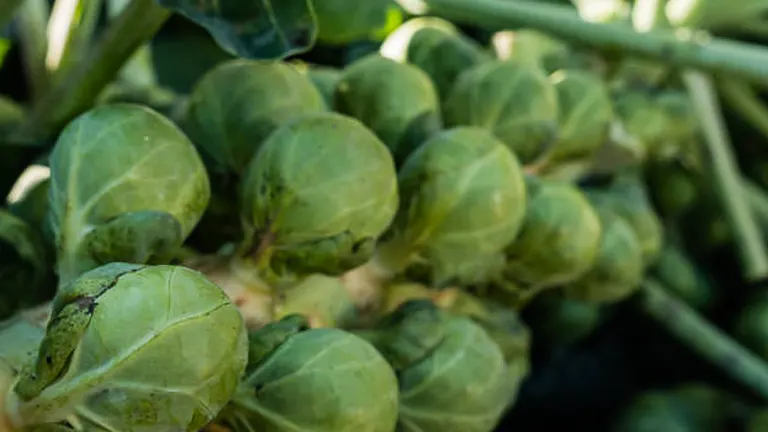
Growing Brussels sprouts can sometimes present challenges, but understanding how to address these issues can greatly improve your gardening success. Here are some common problems and solutions:
- Leaf yellowing and poor growth: This could be a sign of nutrient deficiency, often nitrogen or magnesium. Ensure your soil is rich in organic matter and consider a supplemental feed with a balanced fertilizer. Also, test your soil pH to make sure it’s within the ideal range of 6.0 to 6.8.
- Stunted or loose sprouts: Often caused by too much heat or inadequate nutrients. To avoid this, plant at the correct time to ensure your sprouts mature in cooler temperatures and maintain consistent soil fertility and moisture.
- Bolting (sprouts going to seed prematurely): This can occur if plants are stressed, perhaps by sudden temperature rises or drought. To minimize bolting, use mulch to keep the soil cool and moist and water your plants regularly.
Understanding these common issues can help you maintain a healthy crop, and taking proactive steps to prevent them can ensure your Brussels sprouts thrive.
Related Post
- How to Fertilize Bougainvillea: A Complete Guide for Stunning Blooms
- How to Fertilize Apple Trees: Essential Tips for a Bountiful Harvest
- How to Fertilize Lemon Trees: Secrets for Thriving Citrus
- How to Fertilize Avocado Tree: A Step-by-Step Guide for Lush Growth
Conclusion
Growing Brussels sprouts successfully requires attention to detail and a bit of patience, but the rewards are well worth the effort. By following the easy success strategies outlined in this guide—from selecting the right variety and preparing the soil to proper planting and care techniques—you can enjoy a bountiful harvest of these nutritious, flavorful vegetables. Remember, every garden and gardener is unique, so take the time to learn from each growing season and continue to refine your techniques.
FAQs
- What is the best time of year to plant Brussels sprouts?
Plant Brussels sprouts so they mature in the cooler temperatures of fall. This typically means sowing seeds indoors about 4-6 weeks before the last spring frost, then transplanting outdoors when the seedlings are sturdy and the risk of frost has passed. - How do I choose the right variety of Brussels sprouts for my garden?
Select varieties that are known to perform well in your climate. For cooler climates, look for frost-resistant types. For warmer areas, choose heat-tolerant varieties that can withstand some warmth without bolting. - What type of soil is best for growing Brussels sprouts?
Brussels sprouts thrive in well-draining, fertile soil with a pH of 6.0 to 6.8. Enriching your soil with plenty of organic compost can help ensure the right texture and nutrient content. - How often should I water Brussels sprouts?
Water Brussels sprouts consistently to keep the soil moist but not waterlogged. Aim for about 1 to 1.5 inches of water per week, depending on weather conditions. Use mulch to help retain soil moisture. - Can I grow Brussels sprouts in containers?
Yes, Brussels sprouts can be grown in containers. Choose a deep pot (at least 12 inches) to accommodate the plant’s root system and ensure it has adequate room to grow. Regular watering and fertilization are crucial since container plants can dry out faster and exhaust nutrients more quickly. - What are the common pests that affect Brussels sprouts, and how can I manage them?
Common pests include aphids, cabbage loopers, and flea beetles. Manage them organically with insecticidal soaps, neem oil, or by encouraging beneficial insects such as ladybugs and lacewings into your garden. Regular inspections and cleaning away debris can also prevent infestations. - When and how should I harvest Brussels sprouts?
Harvest when the sprouts are firm and green, about 1 to 1.5 inches in diameter. Start harvesting from the bottom of the plant as these sprouts mature first. Snip the sprouts off the stalk with a sharp knife or twist them off by hand. - How do I store harvested Brussels sprouts for longevity?
Store Brussels sprouts in the refrigerator in a loose, breathable bag for up to several weeks. For longer storage, blanch the sprouts and freeze them. Ensure they are dry before freezing to prevent ice crystals from forming.
With these easy success strategies, you’re well on your way to enjoying delicious, home-grown Brussels sprouts. Remember, a little care goes a long way in yielding a great harvest.
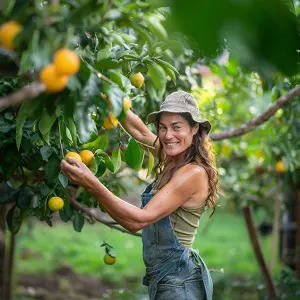
Emma Hudson
Forestry AuthorEmma's experience in farming shapes her detailed guides on gardening and farming tools, providing practical, actionable advice grounded in real-world experience. Her work targets both newcomers and experienced farmers, aiming to enhance their practices with a mix of traditional wisdom and modern techniques. By making complex agricultural concepts accessible, Emma's guides serve as valuable tools for those navigating the challenges of contemporary farming, offering strategies for sustainable success.










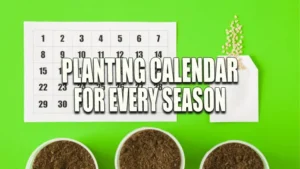
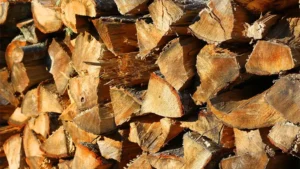

Leave your comment